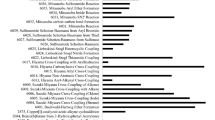Abstract.
Protein design aims to mimic some of the structural and functional properties of native proteins [1-6]. The complexity of the folding mechanism, i.e. the pathway by which a linear polypeptide chain finds its unique 3D-structure, represents one of the most intriguing hurdles in this rapidly growing field. In order to bypass this well-known protein-folding problem [7-10], some years ago we proposed the construction of non-native chain architectures with a high propensity for folding [11-13]. According to this concept, termed TASP (template-assembled synthetic proteins), topological templates [14, 15] are used as a built-in device for directing covalently attached peptide blocks to a predetermined packing arrangement, resulting in branched chain architectures. Recent progress in the synthetic methodology for assembling peptides now allows us to access the full potential of the TASP concept. In this article, we discuss the state of the art of template-based protein de novo design, with special emphasis on progress in peptide synthesis and template design and show that some fundamental questions in protein assembly, structure and function can be approached by designing protein mimetics of reduced structural and functional complexity.
Similar content being viewed by others
Author information
Authors and Affiliations
Rights and permissions
About this article
Cite this article
Mutter, M., Tuchscherer, G. Non-native architectures in protein design and mimicry. CMLS, Cell. mol. life sci. 53, 851–863 (1997). https://doi.org/10.1007/s000180050105
Issue Date:
DOI: https://doi.org/10.1007/s000180050105




